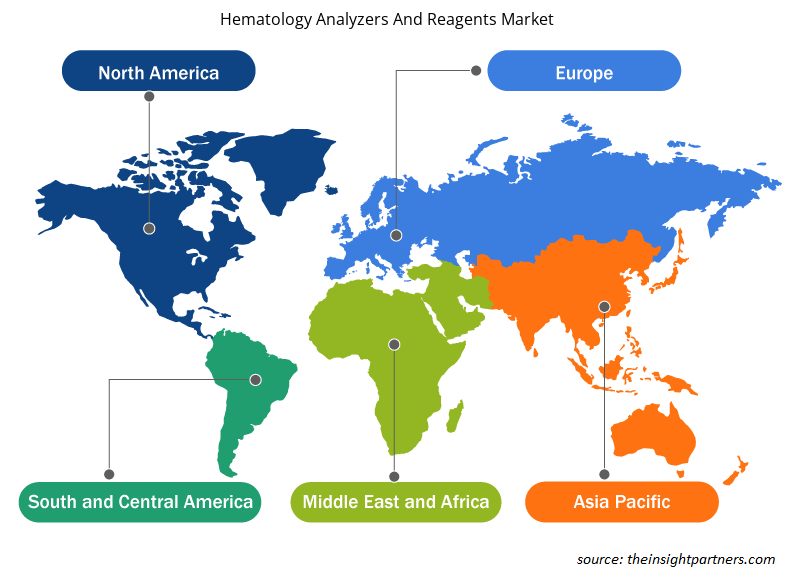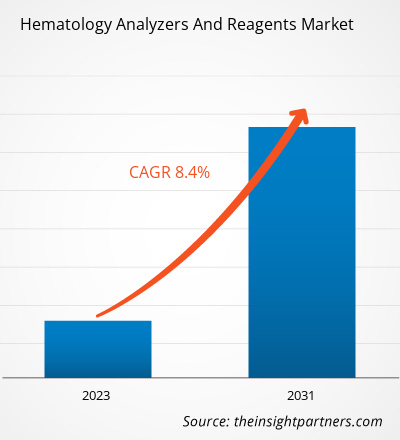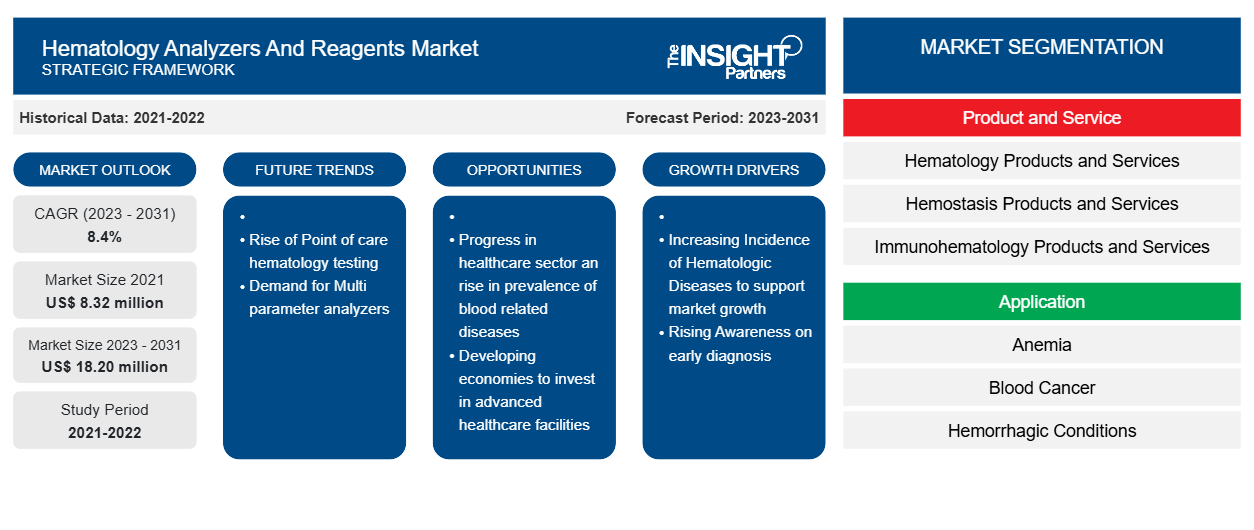Si stima che la dimensione del mercato degli analizzatori e dei reagenti ematologici sia stata di 8,32 milioni di dollari USA nel 2021 e di XX milioni di dollari USA nel 2023 e si prevede che raggiungerà i 18,20 milioni di dollari USA entro il 2031; si stima che registrerà un CAGR dell'8,4% entro il 2031. È probabile che l'adozione crescente di dispositivi intelligenti point-of-care rimanga una tendenza chiave del mercato degli analizzatori e dei reagenti ematologici.
ANALIZZATORI E REAGENTI PER EMATOLOGIA Analisi di mercato
Gli operatori che operano nel mercato degli analizzatori e dei reagenti ematologici sono altamente competitivi e hanno introdotto nuovi prodotti e reagenti. Ad esempio, a gennaio 2024, HORIBA Medical ha lanciato l'ultima piattaforma ematologica automatizzata ad alto rendimento HELO 2.0. La piattaforma è approvata dal Regolamento europeo sui dispositivi diagnostici in vitro (IVDR) CE ed è attualmente in attesa dell'approvazione della Food and Drug Administration (FDA) statunitense. HELO 2.0 è la prossima generazione di gamma ematologica di fascia alta ed è stata sviluppata in consultazione con i clienti per soddisfare tutte le esigenze ematologiche completamente automatizzate ad alto rendimento. HELO 2.0 offre una soluzione ematologica modulare altamente flessibile ed efficiente, che può essere completamente scalata e configurata per soddisfare le diverse esigenze dei laboratori di medie e grandi dimensioni. Analogamente, a maggio 2023, Siemens Healthineers ha lanciato due soluzioni per test ematologici ad alto volume: l'analizzatore Atellica HEMA 570 e l'analizzatore Atellica HEMA 580. La capacità del laboratorio di esaminare e rilasciare rapidamente i risultati dei test dei pazienti è ostacolata dall'ampio utilizzo dei test CBC e dalla crescente carenza di personale. Gli analizzatori Atellica HEMA 570 e Atellica HEMA 580 offrono automazione e intelligenza integrate per migliorare l'efficienza del flusso di lavoro e produrre risultati più rapidi per i pazienti. Il lancio di tali nuovi prodotti sta alimentando la crescita del mercato degli analizzatori e dei reagenti ematologici.
ANALIZZATORI E REAGENTI PER EMATOLOGIA Panoramica del mercato
La crescita del mercato degli analizzatori e dei reagenti ematologici è attribuita al crescente numero di malattie ematologiche e ai progressi tecnologici negli analizzatori ematologici. Tuttavia, i prezzi elevati dei sistemi di fascia alta stanno probabilmente ostacolando la crescita del mercato.
Il mercato globale degli analizzatori e dei reagenti ematologici è segmentato per regione in Nord America, Europa, Asia Pacifico, Medio Oriente e Africa e Sud e Centro America. La regione del Nord America è il maggiore azionista e l'Asia Pacifico è il mercato in più rapida crescita per gli analizzatori e i reagenti ematologici. Si stima che la crescita del mercato degli analizzatori e dei reagenti ematologici abbia una quota maggiore negli Stati Uniti. Si prevede che la crescita del mercato negli Stati Uniti aumenterà a causa di un numero crescente di procedure di analisi del sangue, un'elevata prevalenza di malattie ematologiche, un numero crescente di centri diagnostici e di analisi del sangue e l'accesso a infrastrutture ben sviluppate e altro.
Personalizza questo report in base alle tue esigenze
Riceverai la personalizzazione gratuita di qualsiasi report, comprese parti di questo report, o analisi a livello nazionale, pacchetto dati Excel, oltre a usufruire di grandi offerte e sconti per start-up e università
- Scopri le principali tendenze di mercato in questo rapporto.Questo campione GRATUITO includerà analisi di dati che spaziano dalle tendenze di mercato alle stime e alle previsioni.
ANALIZZATORI E REAGENTI PER EMATOLOGIA Driver di mercato e opportunità
Aumento dell'incidenza delle malattie ematologiche a favore del mercato
Secondo i Centers for Disease Control and Prevention (CDC), circa 12 maschi su 100.000 negli Stati Uniti e 400 ragazzi nascono con l'emofilia A ogni anno. Inoltre, la Leukemia & Lymphoma Society (LLS) segnala che negli Stati Uniti, una persona riceve una diagnosi di linfoma, leucemia o mieloma ogni 3 minuti. Nel 2023, si stima che negli Stati Uniti saranno diagnosticate 184.720 persone con leucemia, linfoma o mieloma. Inoltre, si prevede che i nuovi casi di linfoma, leucemia e mieloma rappresenteranno il 9,4% dei 1.958.310 nuovi casi di cancro che saranno diagnosticati negli Stati Uniti nel 2023. La crescente prevalenza di malattie ematologiche aumenta la richiesta di trasfusioni di sangue e di conteggi delle cellule del sangue per il monitoraggio della normalità, il che sta ulteriormente aumentando la richiesta di analizzatori e reagenti ematologici. L'aumento dell'incidenza delle malattie del sangue sta accelerando la crescita del mercato degli analizzatori e dei reagenti ematologici.
Progressi nei settori sanitari e aumento della prevalenza delle malattie del sangue nelle economie emergenti: un'opportunità nel mercato degli analizzatori e dei reagenti ematologici
L'incidenza delle malattie ematologiche sta aumentando in modo significativo nei paesi in via di sviluppo a causa del cambiamento nello stile di vita delle popolazioni. Inoltre, la crescente prevalenza di altre condizioni di salute dovuta alla riduzione delle attività fisiche e all'aumento dei livelli di stress sta anche contribuendo all'aumento dei casi di disturbi ematologici in questi paesi. Le nazioni in via di sviluppo si stanno impegnando per apportare significativi progressi nelle loro strutture e nei loro servizi sanitari. Ad esempio, la Hemophilia Federation India (HFI) è un'organizzazione senza scopo di lucro che ha lavorato a stretto contatto con la World Federation of Hemophilia (WFH) per aumentare la consapevolezza riguardo all'emofilia e ai trattamenti accessibili disponibili per la stessa, nonché per migliorare la diagnosi della malattia. Inoltre, il team di professionisti RED LAPI si impegna a contribuire e migliorare la diagnosi e il trattamento dell'emofilia in America Latina. Tali sviluppi nel mercato degli analizzatori e dei reagenti ematologici nelle nazioni in via di sviluppo in Asia Pacifico, Medio Oriente e Africa e America Latina stanno offrendo opportunità per la futura crescita degli operatori del mercato.
ANALIZZATORI E REAGENTI PER EMATOLOGIA Rapporto di mercato Analisi della segmentazione
I segmenti chiave che hanno contribuito alla derivazione degli analizzatori e dei reagenti ematologici sono: prodotto e servizio, causa, applicazione e utente finale.
- In base a Prodotto e Servizio, il mercato degli analizzatori e reagenti ematologici è segmentato in prodotti e servizi ematologici, prodotti e servizi emostatici e prodotti e servizi immunoematologici. I prodotti e servizi ematologici sono ulteriormente suddivisi in strumenti, reagenti e materiali di consumo e servizi. Analogamente, il segmento dei prodotti e servizi emostatici è ulteriormente suddiviso in strumenti, reagenti e materiali di consumo e servizi. Anche il segmento dei prodotti e servizi immunoematologici del mercato degli analizzatori e reagenti ematologici è ulteriormente suddiviso in strumenti, reagenti e materiali di consumo e servizi. Il segmento dei prodotti e servizi ematologici ha detenuto una quota di mercato maggiore nel 2023.
- Per applicazione, il mercato è segmentato in anemia, cancro del sangue, condizioni emorragiche, condizioni correlate alle infezioni, condizioni correlate al sistema immunitario e altre applicazioni. Il segmento dell'anemia ha detenuto la quota maggiore del mercato nel 2023.
- In termini di utente finale, il mercato è segmentato in laboratori ospedalieri, fornitori di servizi commerciali, laboratori di riferimento governativi e istituti di ricerca e accademici. Il segmento dei laboratori ospedalieri ha dominato il mercato nel 2023.
Analisi della quota di mercato degli analizzatori e dei reagenti ematologici per area geografica
L'ambito geografico del rapporto di mercato degli analizzatori e reagenti ematologici è suddiviso principalmente in cinque regioni: Nord America, Asia Pacifico, Europa, Medio Oriente e Africa e Sud America/Sud e Centro America.
In Nord America, gli Stati Uniti sono il mercato più grande per la produzione di analizzatori e reagenti ematologici. La crescita del mercato statunitense è guidata principalmente da scenari di ricerca favorevoli, dalla crescente domanda di sangue e componenti del sangue e dall'elevata adozione di strumenti ematologici automatizzati.
Crescente prevalenza di disturbi ematologici come leucemia, emofilia e anemia negli Stati Uniti. Le stime dell'American Cancer Society per la leucemia negli Stati Uniti per il 2024 sono:
- Circa 62.770 nuovi casi di leucemia (tutti i tipi) e 23.670 decessi per leucemia (tutti i tipi)
- Circa 20.800 nuovi casi di leucemia mieloide acuta (LMA). La maggior parte riguarderà gli adulti.
- Circa 11.220 decessi per LMA. Quasi tutti saranno adulti.
Si prevede che la crescente consapevolezza della diagnosi precoce tra i pazienti sarà una delle principali forze trainanti per il mercato degli analizzatori e dei reagenti ematologici. Si prevede che l'Asia Pacifica crescerà con il CAGR più elevato nei prossimi anni.
Analisi regionali del mercato dei reagenti e degli analizzatori ematologici
Le tendenze regionali e i fattori che influenzano il mercato degli analizzatori ematologici e dei reagenti durante il periodo di previsione sono stati ampiamente spiegati dagli analisti di Insight Partners. Questa sezione discute anche i segmenti e la geografia del mercato degli analizzatori ematologici e dei reagenti in Nord America, Europa, Asia Pacifico, Medio Oriente e Africa e America centrale e meridionale.

- Ottieni i dati specifici regionali per il mercato degli analizzatori e dei reagenti ematologici
Ambito del rapporto di mercato sugli analizzatori e reagenti ematologici
| Attributo del report | Dettagli |
|---|---|
| Dimensioni del mercato nel 2021 | 8,32 milioni di dollari USA |
| Dimensioni del mercato entro il 2031 | 18,20 milioni di dollari USA |
| CAGR globale (2023-2031) | 8,4% |
| Dati storici | 2021-2022 |
| Periodo di previsione | 2023-2031 |
| Segmenti coperti | Per prodotto e servizio
|
| Regioni e Paesi coperti | America del Nord
|
| Leader di mercato e profili aziendali chiave |
|
Analizzatori e reagenti ematologici Mercato degli attori Densità: comprendere il suo impatto sulle dinamiche aziendali
Il mercato degli analizzatori e dei reagenti ematologici sta crescendo rapidamente, spinto dalla crescente domanda degli utenti finali dovuta a fattori quali l'evoluzione delle preferenze dei consumatori, i progressi tecnologici e una maggiore consapevolezza dei benefici del prodotto. Con l'aumento della domanda, le aziende stanno ampliando le loro offerte, innovando per soddisfare le esigenze dei consumatori e capitalizzando sulle tendenze emergenti, il che alimenta ulteriormente la crescita del mercato.
La densità degli operatori di mercato si riferisce alla distribuzione di aziende o società che operano in un particolare mercato o settore. Indica quanti concorrenti (operatori di mercato) sono presenti in un dato spazio di mercato in relazione alle sue dimensioni o al valore di mercato totale.
Le principali aziende che operano nel mercato degli analizzatori e dei reagenti ematologici sono:
- Soluzioni per la diagnostica clinica, Inc.
- Azienda: Shenzhen Mindray Bio-Medical Electronics Co., Ltd.
- Danaher
- LABORATORI BIO-RAD INC.
- Abate
- Diatron
Disclaimer : le aziende elencate sopra non sono classificate secondo un ordine particolare.

- Ottieni la panoramica dei principali attori del mercato degli analizzatori e dei reagenti ematologici
Analizzatori e reagenti ematologici: notizie di mercato e sviluppi recenti
Il mercato degli analizzatori e dei reagenti ematologici viene valutato raccogliendo dati qualitativi e quantitativi post-ricerca primaria e secondaria, che includono importanti pubblicazioni aziendali, dati di associazioni e database. Di seguito è riportato un elenco di sviluppi nel mercato degli analizzatori e dei reagenti ematologici e delle strategie:
- HORIBA Medical ha lanciato nuovi prodotti nella sua famiglia di prodotti ematologici Yumizen. L'azienda ha introdotto due analizzatori ematologici da banco compatti, Yumizen H500 e Yumizen H550, che offrono prestazioni migliorate, nuove funzionalità e maggiori vantaggi. Questi analizzatori sono stati progettati per fornire un report ematologico rapido e completo con un'elevata produttività di 60 test all'ora, autonomia di 40 provette con caricamento continuo, modalità manuale urgente e modalità multi-analisi e campionamento per l'esecuzione di campioni. (Fonte: HORIBA Medical, 2022)
- Mindray ha lanciato una serie rivoluzionaria di analizzatori ematologici, la serie BC-700, che incorpora sia l'emocromo completo (CBC) che i test della velocità di eritrosedimentazione (VES). La serie include due modelli a fiala aperta, BC-700/BC-720, e due modelli autoloader, BC-760/BC-780. Questa serie è progettata per potenziare i laboratori di medio volume con tecnologie diagnostiche avanzate applicate a prodotti premium. (Fonte: Shenzhen Mindray Bio-Medical Electronics Co., Ltd., Comunicato stampa, 2022)
Copertura e risultati del rapporto di mercato sugli analizzatori e reagenti ematologici
Il rapporto "Dimensioni e previsioni del mercato degli analizzatori e dei reagenti ematologici (2021-2031)" fornisce un'analisi dettagliata del mercato che copre le seguenti aree:
- Dimensioni e previsioni del mercato a livello globale, regionale e nazionale per tutti i segmenti di mercato chiave coperti dall'ambito
- Dinamiche di mercato come fattori trainanti, vincoli e opportunità chiave
- Principali tendenze future
- Analisi dettagliata delle cinque forze PEST/Porter e SWOT
- Analisi di mercato globale e regionale che copre le principali tendenze di mercato, i principali attori, le normative e gli sviluppi recenti del mercato
- Analisi del panorama industriale e della concorrenza che copre la concentrazione del mercato, l'analisi della mappa di calore, i principali attori e gli sviluppi recenti
- Profili aziendali dettagliati
- Analisi storica (2 anni), anno base, previsione (7 anni) con CAGR
- Analisi PEST e SWOT
- Valore/volume delle dimensioni del mercato - Globale, Regionale, Nazionale
- Industria e panorama competitivo
- Set di dati Excel
Report recenti
Testimonianze
Motivo dell'acquisto
- Processo decisionale informato
- Comprensione delle dinamiche di mercato
- Analisi competitiva
- Analisi dei clienti
- Previsioni di mercato
- Mitigazione del rischio
- Pianificazione strategica
- Giustificazione degli investimenti
- Identificazione dei mercati emergenti
- Miglioramento delle strategie di marketing
- Aumento dell'efficienza operativa
- Allineamento alle tendenze normative





















 Ottieni un campione gratuito per - Mercato degli analizzatori e dei reagenti ematologici
Ottieni un campione gratuito per - Mercato degli analizzatori e dei reagenti ematologici